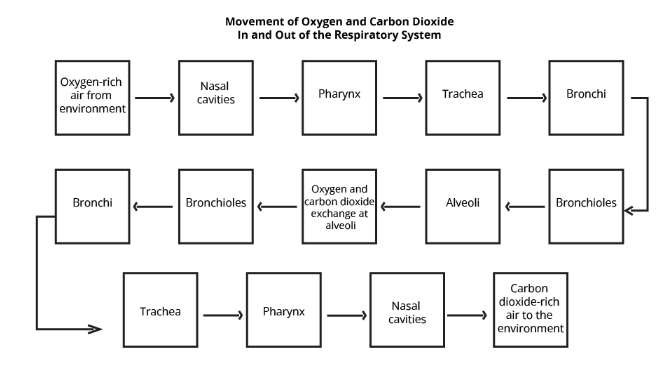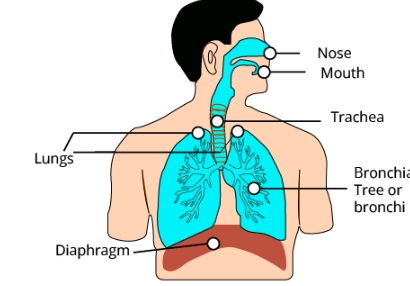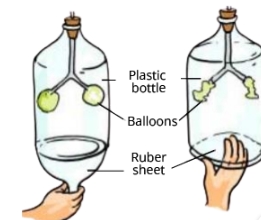
Important Questions for Class 7 Science Chapter 6: Chapter 6 of Class 7 Science, "Respiration in Organisms," explores the process by which living organisms obtain energy from food. It covers types of respiration—aerobic (with oxygen) and anaerobic (without oxygen).
The chapter explains the role of oxygen in the breakdown of glucose to release energy, forming carbon dioxide and water as byproducts. It discusses the respiratory systems in humans, plants, and animals, including breathing and cellular respiration. Key topics include the structure of the human respiratory system, the process of gaseous exchange, and the importance of respiration in maintaining life.Important Questions for Class 7 Science Chapter 6 Overview
Chapter 6 of Class 7 Science, "Respiration in Organisms," highlights key concepts like the process of respiration, types (aerobic and anaerobic), and their significance in energy production. Important questions in this chapter include the differences between breathing and respiration, the structure and function of the human respiratory system, and the role of oxygen in cellular respiration. Important Questions for Class 7 Science Chapter 6 are crucial as they help students understand how energy is released from food, enabling organisms to perform vital functions. Understanding respiration also lays the foundation for comprehending other biological processes like metabolism, growth, and energy transfer in ecosystems.Important Questions for Class 7 Science Chapter 6 PDF
Important Questions for Class 7 Science Chapter 6 Respiration in Organisms
Below is the Important Questions for Class 7 Science Chapter 6 Respiration in Organisms - Very Short Answer Questions. (1 Mark)- Fill in the blanks:
- Lactic acid is produced during _______________ respiration.
Ans: Ethanol
- During anaerobic respiration yeast produces _________________.
Ans: Absence
- Anaerobes are organisms that can survive in the ______________ of air.
Ans: Oxygen-rich
- Intake of ____________________ air is called inhalation.
Ans: Carbon dioxide
- Exhaled air is rich in _________________.
Ans: Accumulation
- Muscle cramps are caused due to the ________________ of lactic acid in muscle cells.
Ans: Spiracles
- Small openings in the side of the body of the cockroach for the exchange of gases are called ____________.
Ans: Tracheae
- Network of air tubes inside the body of insects is called ______________.
Ans: Tracheae
- Earthworms and __________________ breathe through their moist skin.
Ans: Frogs
- Gills are respiratory organs found in ______________.
Ans: Fishes
Short Answer Questions (2 Marks)
2. Differentiate between anaerobic respiration in muscle cells and that in yeast.Ans: The difference between anaerobic respiration in muscles cells and that in yeast are as follows:
| Anaerobic Respiration in Muscle Cell | Anaerobic Respiration in yeast |
| Occurs in insufficient supply of air. | Occurs in insufficient or absence of air. |
| Produces Lactic Acid | Produces Ethanol |
| It can cause muscle cramps. | It causes fermentation of sugar-rich substances to alcohol |
3. Differentiate between respiration in insects and earthworms.
Ans: Insects respire through small openings called spiracles on their bodies, which lead to a network of tubes called tracheae . Earthworms, on the other hand, respire through their skin , absorbing oxygen directly from the environment and releasing carbon dioxide. Both processes help in the exchange of gases for energy.
4. Give the pathway of air during respiration
Ans: The pathway is depicted as below:

5. Give the composition of inhaled and exhaled air.
Ans: The composition of air is as follows:
-
The oxygen content of inhaled air is 21% and the carbon dioxide content is 0.04 percent.
-
Exhaled air has a 16.4 percent oxygen content and a 4.4 percent carbon dioxide content.
6. Give the reactions for aerobic and anaerobic respiration in muscle cells.
Ans:

Long Answer Questions (5 Marks)
7. Draw and label the respiratory system in humans.
Ans:

8. Give an experiment to demonstrate the role of the diaphragm in breathing.
Ans: An experiment can be put up to demonstrate the role of the diaphragm in breathing.
- Remove the bottom of a plastic bottle with a wide mouth.
- A glass or plastic tube in the shape of a Y is placed inside the bottle lid.
- The forked end of the bottle has two deflated balloons attached to it. The bottle's cap is attached firmly.
- To conceal the bottle's bottom, a thin rubber sheet has been securely wrapped around it.
- Pulling the rubber sheet away from the base causes the balloons to expand, while pressing the rubber sheet inward causes them to deflate.
In the experiment, the rubber sheet represents the diaphragm, and the balloons represent the lungs. When the diaphragm flattens out, the lungs enlarge. When the diaphragm returns to its dome position, the lungs contract.

9. Explain how respiration occurs in plants.
Ans: Plants use aerobic respiration to function. Microscopic holes on the aerial surfaces of plants, like leaves, allow gases to be transported. We refer to these pores as stomata. The small pores on the underside of the leaves are called stomata. When the stomata are open, gas exchange takes place. Because sunlight is available during the day, photosynthesis occurs in plants, and gases are exchanged for this process. Oxygen is exhaled, while carbon dioxide is consumed.
Thus, the majority of plant respiration takes place at night. The plants absorb oxygen from their surroundings and exhale carbon dioxide at night. After that, oxygen is used by plants to breathe. Additionally, plant root cells need energy, which is why aerobic respiration uses oxygen. The air between soil particles is used by root cells to absorb oxygen. Overwatering suffocates the air spaces in the soil, making it impossible for the root to breathe. Thus, it is best to avoid overwatering the soil.
10. Differentiate between inhalation and exhalation
Ans: The difference between inhalation and exhalation is:
Inhalation is the process of taking air into the lungs. During inhalation, the diaphragm moves down, and the chest expands, allowing oxygen to enter the body. Exhalation is the process of breathing out air from the lungs. During exhalation, the diaphragm moves up, and the chest contracts, releasing carbon dioxide. Inhalation brings oxygen, and exhalation removes waste gases, helping the body function properly.
Benefits of Using Important Questions for Class 7 Science Chapter 6
Using important questions for Class 7 Science Chapter 6, "Respiration in Organisms," offers several benefits:Enhanced Understanding : These questions help reinforce key concepts like aerobic and anaerobic respiration, aiding in better comprehension of the topic.
Focused Preparation : They highlight critical areas of the chapter, enabling targeted revision.
Exam Readiness : Practicing these questions boosts confidence and ensures readiness for exams.
Improved Retention : Regular practice helps retain essential information about respiration processes and their significance in living organisms.
Concept Clarity : Helps clarify complex concepts like energy release, breathing, and cellular respiration.
Important Questions for Class 7 Science Chapter 6 FAQs
How does respiration take place in all organisms?
Who discovered respiration in organisms?
What is the activity for respiration in organisms?
What is the purpose of respiration in organisms?








